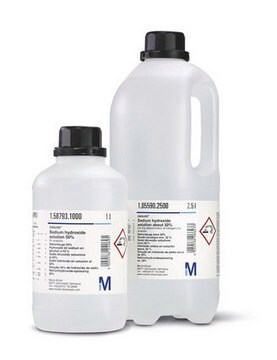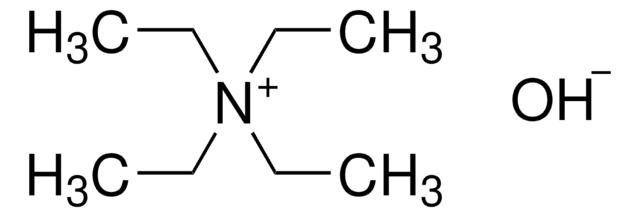1.08124
Tetramethylammonium hydroxide solution
c(C₄H₁₃NO)=0.1 mol/l (0.1 N) in 2-propanol/methanol, ready-to-use volumetric solution for titration in non-aqueous media, Titriplex®
About This Item
Recommended Products
Product Name
Tetramethylammonium hydroxide solution, in 2-propanol/methanol for titrations in non-aqueous media c(C4H13NO)=0.1 mol/l (0.1 N), Titripur®
Quality Level
product line
Titripur®
form
liquid
quality
Analyzed in our ISO 17025 accredited QC lab
reaction suitability
reaction type: Acid-base reactions
reaction type: Redox Reactions
concentration
0.1 M
technique(s)
titration: suitable
pH
14 (20 °C in H2O)
transition temp
flash point 15 °C
density
0.79 g/cm3 at 20 °C
storage temp.
15-25°C
Related Categories
Application
- An Approach Based on an Increased Bandpass for Enabling the Use of Internal Standards in Single Particle ICP-MS: Application to AuNPs Characterization.: This study by Bazo et al. (2023) explores the use of Tetramethylammonium hydroxide solution to enhance internal standard applications in single particle ICP-MS for gold nanoparticle characterization. This method improves accuracy and reliability in nanoparticle detection (Bazo et al., 2023).
- Titanium dioxide nanoparticles assessment in seaweeds by single particle inductively coupled plasma - Mass spectrometry.: López-Mayán et al. (2022) utilized Tetramethylammonium hydroxide solution for the assessment of titanium dioxide nanoparticles in seaweeds. This approach allows for precise quantification and analysis of nanoparticles in complex matrices (López-Mayán et al., 2022).
- Determination of selenite and selenomethionine in kefir grains by reversed-phase high-performance liquid chromatography-inductively coupled plasma-optical emission spectrometry.: Bodur et al. (2021) used Tetramethylammonium hydroxide solution to effectively separate and quantify selenite and selenomethionine in kefir grains, demonstrating its utility in food chemistry applications (Bodur et al., 2021).
- Application of TMAH thermochemolysis to the detection of nucleobases: Application to the MOMA and SAM space experiment.: He et al. (2019) applied Tetramethylammonium hydroxide solution in thermochemolysis for detecting nucleobases in space mission experiments, demonstrating its application in astrobiology and space chemistry (He et al., 2019).
Features and Benefits
This volumetric solution is analyzed by our calibration laboratory D-K-15185-01-00 which is accredited according to DIN EN ISO/IEC 17025 for analysis of amount-of-substance concentrations in volumetric solutions by DAkkS (Deutsche Akkreditierungsstelle - German National Accreditation Body). The accreditation certificate can be found at www.sigmaaldrich.com/ISO17025.
Analysis Note
Amount-of-substance concentration 0.0994 - 1.006 mol/L
Measurement uncertainty ± 0.0004 mol/L
Traceability NIST SRM
The concentration is determined by volumetric titration and refers to 20°C.
The amount-of-substance concentration of this volumetric solution is traceable to a primary standard reference material (SRM) from the National Institute of Standards and Technology, Gaithersburg, USA (NIST SRM 350 benzoic acid) by means of volumetric standard benzoic acid (article number 1.02401), certified reference material according to ISO 17034, analyzed by our accredited calibration laboratory of Merck KGaA, Darmstadt, Germany according to DIN EN ISO/IEC 17025. The uncertainty is expressed as expanded measurement uncertainty with a coverage factor k=2 covering a confidence level of 95%.
Note: The titer is a correction factor to correct for variations of the volumetric solution, the titration equipment, the temperature and other laboratory conditions. For correct titration results it is recommended to determine a titer with the laboratory specific equipment and under laboratory specific conditions directly after opening a new bottle and at regular time intervals.
Legal Information
related product
Signal Word
Danger
Hazard Statements
Precautionary Statements
Hazard Classifications
Acute Tox. 3 Dermal - Acute Tox. 3 Oral - Acute Tox. 4 Inhalation - Eye Dam. 1 - Flam. Liq. 2 - Skin Corr. 1 - STOT RE 2 Dermal - STOT SE 1 - STOT SE 3
Target Organs
Central nervous system
Storage Class Code
3 - Flammable liquids
WGK
WGK 2
Flash Point(F)
59.0 °F
Flash Point(C)
15 °C
Certificates of Analysis (COA)
Search for Certificates of Analysis (COA) by entering the products Lot/Batch Number. Lot and Batch Numbers can be found on a product’s label following the words ‘Lot’ or ‘Batch’.
Already Own This Product?
Find documentation for the products that you have recently purchased in the Document Library.
Customers Also Viewed
Our team of scientists has experience in all areas of research including Life Science, Material Science, Chemical Synthesis, Chromatography, Analytical and many others.
Contact Technical Service


![Tetra-n-butylammonium hydroxide solution in 2-propanol/methanol for titrations in nonaqueous media c[(C4H9)4NOH] = 0.1 mol/l (0.1 N), Titripur®, reag. USP](/deepweb/assets/sigmaaldrich/product/images/217/795/18cba546-7592-4bb4-8b67-0b4b229e0a2f/640/18cba546-7592-4bb4-8b67-0b4b229e0a2f.jpg)







